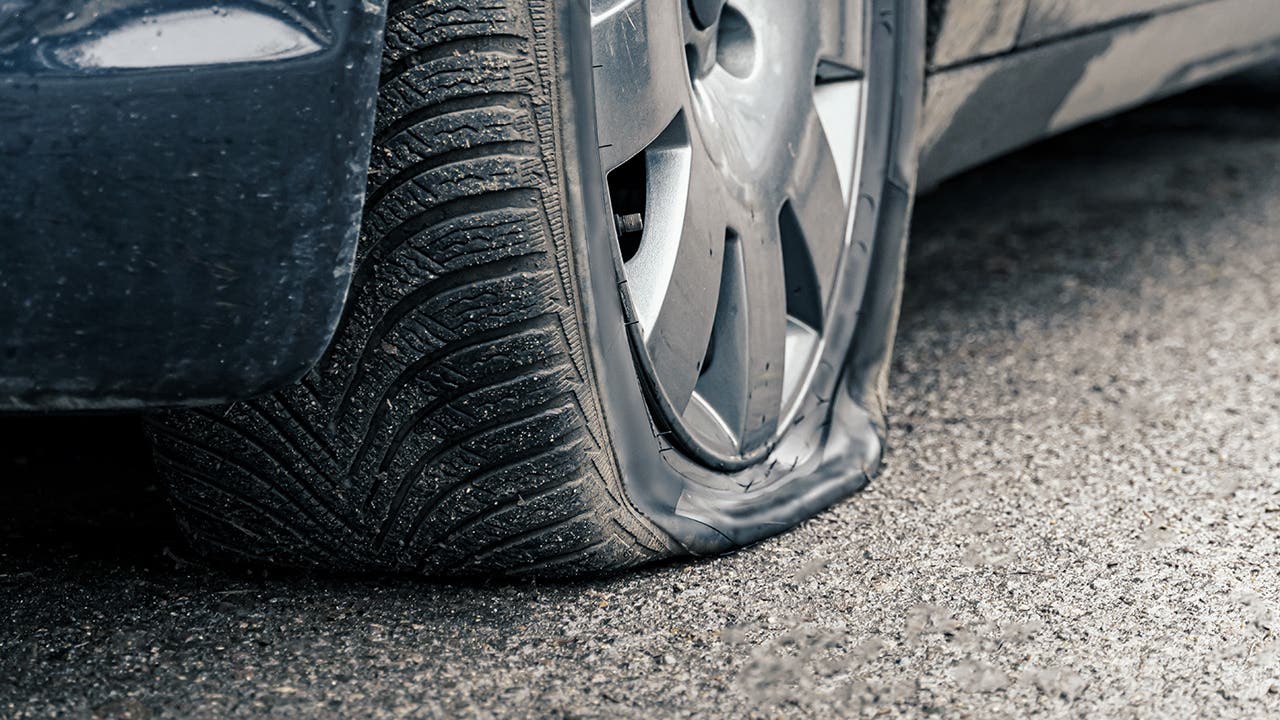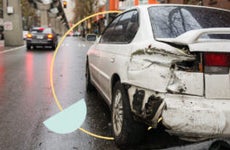Flat tire facts and guide

The Bankrate promise
At Bankrate, we strive to help you make smarter financial decisions. To help readers understand how insurance affects their finances, we have licensed insurance professionals on staff who have spent a combined 47 years in the auto, home and life insurance industries. While we adhere to strict , this post may contain references to products from our partners. Here's an explanation of . Our content is backed by Coverage.com, LLC, a licensed entity (NPN: 19966249). For more information, please see our .
Most drivers deal with a flat tire now and then, but there are steps you can take to avoid a blowout any more than is necessary. Having a flat tire when you’re driving at high speed can be dangerous, after all, and repair costs can be high if your flat tire is not taken care of quickly. It’s important to do whatever you can so that your tires are in good shape and able to handle the road in all types of weather and driving situations. Bankrate’s insurance editorial team reviewed what you need to do in the event of a flat, and how you can avoid one in the first place.
Flat tire statistics
Even with proper care, you may experience a flat tire from time to time. Sharp objects in the road may pierce a tire, or you may be the victim of vandalism, for example. Consider the following flat tire statistics, which indicate that flat tires are more common than you might have thought:
- In 2021, there were 622 traffic fatalities caused by a tire-related crash. (NHTSA)
- Only about 16 percent of new vehicles are equipped with run-flat tires, which allow you to drive on a flat tire for roughly 50 miles. (Edmunds)
- In the United States, one tire puncture occurs every seven seconds, which results in roughly 220 million flat tires each year. (Torque News)
- 42.2 percent of drivers are confident they can change a flat tire, while more than 20 percent have no idea how to handle this task. (NBC News)
- Data from Consumer Reports indicates that only about 10 percent of new cars come with a full-sized spare. Roughly 60 percent have a temporary spare, and the rest come with a sealant kit, run-flat tire or nothing at all. (Consumer Reports)
What causes a flat tire?
You might assume that flat tires on the highway are only caused by punctures from road debris or sharp objects. But in reality, there are many variables that can cause a flat tire. Here are some of the most common causes of flat tires:
- Overinflated tires: A tire with too much air in it is at risk of internal damage and possible leakage. It’s a good idea to use a tire gauge to ensure that you are only filling your tire up to the maximum recommended PSI, and never more.
- Road debris: This common cause of flat tires can happen to anyone. You may drive over a discarded nail, broken glass or construction debris that isn’t visible to you in the driver’s seat, and find yourself with either a slow leak or puncture.
- Valve damage: Your tires valves are easily damaged, which can lead to a flat tire. Be sure to treat them gently when you are installing or refilling your tires with air.
- Temperature: Both very hot or bitterly cold temperatures are bad for tires. In cold weather, the tire contracts slightly, which can result in leakage. Hot weather, meanwhile, causes an expansion of the rubber, possibly leading to leaks or bursts.
- Vandalism: Deliberate slashing or puncturing is likely to result in a flat.
- Old tires: You’re more likely to experience a flat with older, worn tires than you are with tires that are on the newer side. It’s a good idea to monitor the tread and general look of your tires so you know when it’s time to replace them.
What should I do if I get a flat tire?
Your first reaction to a flat tire may be uncertainty. What is the best way to handle it? Fortunately, you have several options you can use, although they may depend on what supplies you have in your car. Here are some options for you to consider.
Tools for changing a flat tire
If you decide to change a flat tire yourself, there are a few tools you should have handy. Consider adding these to your car’s supplies before the need becomes urgent:
- Spare or donut tire: Although many car manufacturers now include a short-term donut tire with new cars, a few still include a full-size spare tire. It is usually located in the trunk or under the vehicle. If your car does not have a spare tire of some kind, it may be a good idea to purchase one in the event that you have a flat.
- Car jack: These essential tools lift the car high enough that you are able to remove and replace the tire. Some cars come with a jack. It can be helpful to know ahead of time whether your car does have one or if you need to purchase it separately. Many vehicles include a flat plastic area under the bottom of the car where the jack fits when in use, to give you the best leverage for the task.
- Lug wrench: Tires are normally attached to the car using lug nuts and bolts. A lug wrench is the tool you need to be able to loosen and remove them to change your tire.
- Safety road reflectors: Although your best bet when changing a tire is to be off the road completely, this may not always be possible. In that event, safety reflectors or flares are vital to protect you from oncoming traffic. You may also want to invest in an orange safety vest to make it even easier for drivers to see you.
- Pressure gauge: Every driver should have a small pressure gauge that they can use to test the pressure (PSI, or pounds-per-square-inch) of their car’s tires. When changing your tire, it’s a good idea to check the pressure once the new tire is installed. You can find the recommended PSI on the side of the spare tire or on the label on the car’s door frame.
Tips for changing a flat tire
So what should you do if you have a flat tire and wish to change it yourself? Here are some action steps from tire manufacturer Bridgestone that can help you through the process:
- Be sure you’re in a safe location, out of the flow of traffic. Turn on your hazard lights to alert other drivers.
- Apply your parking brake and insert wheel wedges in front of or behind tires so the car can’t roll.
- Remove hubcap or wheel cover, if you have one. You will need a lug wrench for this.
- Place your jack under the vehicle, alongside the flat tire. Some vehicles have a plastic base under the car where you can place the jack. Raise the car using the jack.
- Unscrew lug nuts and remove the flat tire.
- Place the spare on the hub, lining up the rim with the lug bolts. Push gently until you can see the lug bolts through the rim.
- Tighten lug nuts by hand.
- Lower the car, and tighten the lug nuts again using the lug wrench.
What if I don’t have a spare tire?
As we noted above, not all cars come with a spare tire. If your vehicle does not have one, there are still steps you can take to get back on the road again after a flat tire. Consider the following ways you can be prepared:
- Fix-a-flat spray: Fix-a-flat spray can help you plug a tire leak quickly. After identifying the leak, move your car so the leaking spot is in the 6 o’clock position, then dispense the entire can of sealant on the leak. Keep in mind that this is a temporary repair and you should only use it to safely drive to an auto body shop.
- Car tire repair kit: Having a car tire repair kit in your car can come in handy if you get a flat. These kits often include a patch that can be adhered to the leak, but don’t provide a permanent fix.
- Tire plug kit: With a tire plug kit, you can stick a plug in the hole that is leaking. However, you might have to remove the tire in order to use the plug, depending on where the leak is located. Plugged tires can be driven on for roughly 10 miles, so you still need to get the tire replaced as soon as possible.
- Switch to run-flat tires: If you don’t feel comfortable changing a flat tire yourself or don’t have the tools, consider upgrading your tires to run-flats. As the name suggests, these tires are designed to allow you to continue driving for a short distance after getting a flat. It’s not a permanent solution, but it does not require any work on your end.
Call roadside assistance
Ultimately, many drivers who get flat tires choose to call roadside assistance to help them get back on the road. Roadside assistance can provide basic vehicle repairs and towing, including flat tire changes, battery replacement, fuel delivery, extrication and sometimes locksmith services.
There are a few ways to get roadside assistance. One option is to purchase a plan through an organization like AAA, which has an annual membership fee and offers several tiers of coverage. You can also get roadside assistance through most car insurance companies for a small increase in your monthly premium.
If you’re interested in purchasing a roadside assistance plan, it’s a good idea to compare a few options and get quotes to see which one is the cheapest one. You should also pay attention to the benefits you receive with each plan, as every roadside assistance package offers different services, maximum towing mileages and availability.
Does car insurance cover a flat tire?
Car insurance will sometimes cover a flat tire, but it depends on the specific situation. For example, if your car gets vandalized and someone slashed the tires, the comprehensive portion of your car insurance policy would pay to replace the tires (minus your deductible). However, car insurance companies would not pay for new tires if you got a flat due to road debris, temperatures or general wear and tear.
If you get a flat tire, whether it’s caused by vandalism or a random act, keep in mind that you don’t necessarily have to replace the tire. Depending on the type of damage and the severity of the leak, you may be able to patch the tire instead, which could help you save a significant amount of money. The cost of a brand new tire can range anywhere from $100 to $300 on average, whereas a patch only costs $15 to $30 on average.
Flat tire accident statistics
You might assume that a flat tire is just an inconvenience, but in reality, tire blowouts can cause accidents, including both multi- and single-vehicle crashes. For instance, if you get a flat tire on a busy roadway, you might lose control of the vehicle and swerve into oncoming traffic. Or, you might run into a stationary object, like a telephone pole or fence.
Flat tire accidents are more common than you may think—here is some data to be aware of:
- On an annual basis, an estimated 11,000 accidents are caused by bad tires, resulting in roughly 600 fatalities. (NHTSA)
- Vehicles with underinflated tires are up to three times more likely to be involved in a tire-related crash than vehicles with properly inflated tires. (Consumer Reports)
- Only 42 percent of drivers regularly check their tire pressure, although 75 percent of all roadside flats are preceded by a slow leak or underinflation. (United Tires)
- In a study of 5,470 car accidents, it was determined that 45 percent of SUVs that rolled over had tire-related issues before the crash occurred. (United Tires)
- The states with the highest reported number of tire-related crashes include Texas, Kansas and Pennsylvania. (United Tires)
How to prevent a flat tire
For any car, flat tires are not entirely preventable, but there are easy ways to lower your risk of getting a flat or blowing a tire while driving. Here are a few tips:
- Check tire pressure: Keeping an eye on your tire pressure is an excellent way to avoid flats. If you notice a tire that is looking low, use a tire pressure gauge to check the pressure. In general, it’s a good idea to check your tire pressure every few weeks, and always before going on a long road trip.
- Avoid construction areas: You might be more likely to get a flat tire when driving through a construction area, as nails, metal, staples and other sharp objects can get left on the road and puncture tires. When you can, avoid driving through construction zones, and if it’s unavoidable, proceed with caution and look out for obvious hazards.
- Park in a garage: To avoid flat tires, opt for parking garages rather than street parking when possible. It can reduce the risk of vandalism where your tires could get slashed.
- Replace tires as needed: Although tires can be expensive, it’s important to replace your tires as needed to avoid flats. You should get a new set of tires every six to 10 years, or more frequently, depending on how often you drive. If you avoid replacing your tires, it can increase the likelihood of a flat and a tire-related accident.
Frequently asked questions
-
-
That depends on how severe the puncture is and how much air is leaking out. According to Progressive Insurance, if it is a slow leak or you cannot tell if any air is leaking out, your best bet is to leave the nail where it is and proceed to a mechanic or tire store. If air is leaking out quickly, however, it may be a better idea to pull the nail and do a quick patch of the hole or call for roadside assistance. Either way, it is probably a bad idea to ignore the nail and continue driving without addressing the issue as soon as possible.
-
You can repair a tire that has up to two punctures, according to Firestone, as long as the punctures are at least 16 inches apart and are less than one-quarter inch in diameter. If your car has more than two punctures, Firestone recommends that you purchase a new tire.
-
Unless you have run-flat tires, you should drive as little as possible with a flat tire, for several reasons. Driving on a flat may make the puncture worse, causing severe damage to the tires, and making it impossible to repair them. You may also damage the rims, which can become bent or warped. In the worst cases, driving on a flat tire can damage other parts of your car, such as your brake lines, rotors and suspension, all of which put you at risk of an accident and higher repair costs.
-
Related Articles



